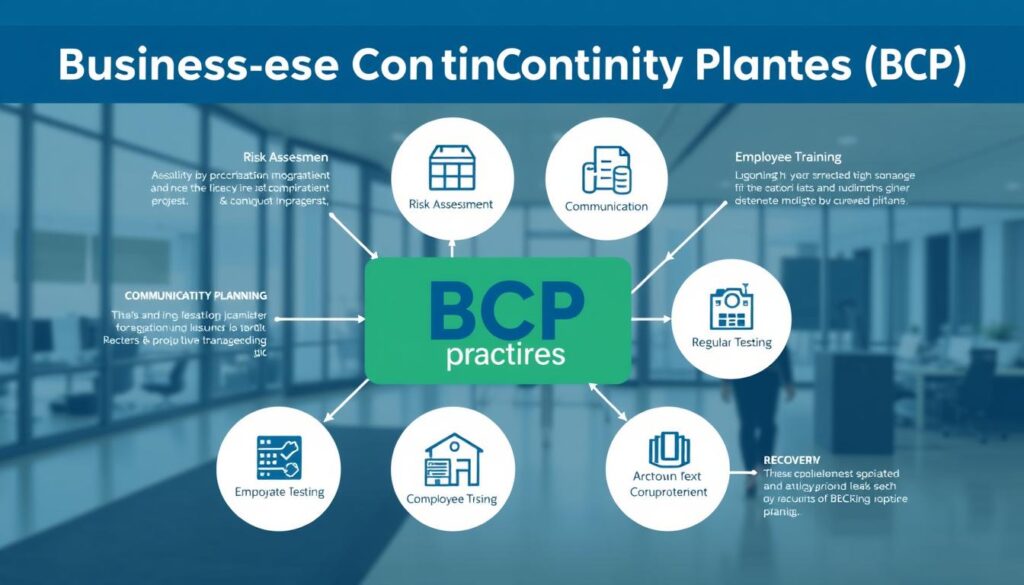In today’s fast-paced business world, companies face many risks. These risks include natural disasters, cyberattacks, and equipment failures. Having a plan for crisis management is now essential. It helps keep businesses running smoothly and protects their future.
At the core of this challenge are two strategies: Business Continuity Planning (BCP) and Disaster Recovery Planning. They both help keep organizations strong. But they focus on different things and use different methods.
BCP looks at all possible threats and aims to lessen their effects. It helps keep key business activities going. Disaster recovery planning is more focused. It deals with getting an organization’s IT systems and data back after a disaster.
Key Takeaways
- Business Continuity Planning (BCP) is a comprehensive strategy to minimize the impact of disruptions and maintain critical business functions.
- Disaster Recovery Planning is a specialized discipline focused on restoring an organization’s IT infrastructure and data after a disaster.
- BCP takes a proactive approach to risk assessment and mitigation, while disaster recovery planning is more reactive in nature.
- Effective BCP and disaster recovery planning work in tandem to ensure operational resilience and a seamless response to various threats.
- Integrating BCP and disaster recovery planning is crucial for achieving true organizational resilience and preparedness.
Understanding Business Continuity Planning (BCP)
Business Continuity Planning (BCP) helps organizations deal with disruptions. It ensures critical functions keep running even when things go wrong. BCP looks at possible threats, their effects, and makes plans to keep operations going during tough times.
What is BCP?
BCP is a proactive way to find and fix weaknesses in an organization. It aims to lessen the chance of operations stopping and quickly bounce back from surprises. By looking closely at what’s most important, BCP helps make plans to keep services running and get back to normal fast.
Importance of BCP in Organizations
- BCP helps organizations prepare for and get through crises like natural disasters or cyber-attacks.
- It makes sure key operations keep going, helping to serve customers or stakeholders even when things are tough.
- Good BCP reduces the financial and damage to reputation from sudden stops in operations.
- Many industries need to follow strict rules about having solid business continuity and disaster recovery plans.
- Having a strong BCP can give a company an edge over competitors.
In today’s fast-changing business world, having a strong Business Continuity Planning strategy is key. It’s vital for risk management and operational resilience.
Disaster Recovery Planning: A Crucial Component
Disaster recovery planning is key in business continuity. It helps restore an organization’s IT infrastructure and data after a disaster. A good disaster recovery strategy includes planning for data backup, system restoration, and IT resilience. This ensures businesses can quickly get back to normal.
It’s vital for all businesses to have a disaster recovery plan. This plan helps protect against natural disasters, cyberattacks, and other crises. By testing and updating a disaster recovery plan, companies can reduce downtime and keep operations running smoothly during emergencies.
Understanding how to back up and recover data is central to disaster recovery planning. Using strong backup methods, whether on-site or in the cloud, is key. Also, having a resilient IT infrastructure that can handle disasters is crucial.
“Disaster recovery planning is not just about technology; it’s about people, processes, and the ability to adapt and respond to the unexpected.” – John Doe, Disaster Recovery Expert
Adding disaster recovery planning to a business’s strategy helps tackle unexpected events. It protects operations and ensures the company’s long-term success.
How BCP Differs from Disaster Recovery Plan
BCP and disaster recovery planning are similar but not the same. BCP looks at the whole organization, including people, processes, and resources. It aims to keep the business running smoothly. Disaster recovery focuses on getting IT systems and data back after a problem.
Scope and Focus
BCP helps an organization keep up its key operations and services, even when things go wrong. It deals with risks and tries to lessen the blow from different problems, like natural disasters or cyber attacks. Disaster recovery, however, is all about fixing the IT setup and data after a big issue.
Proactive vs. Reactive Approach
BCP is proactive, looking ahead to find and deal with threats. It trains employees, has backup plans, and sets up backup work spots. Disaster recovery is reactive, focusing on fixing systems and data after a disaster strikes.
| Business Continuity Planning (BCP) | Disaster Recovery Planning |
|---|---|
| Broad, proactive focus on organizational resilience | Narrow, reactive focus on IT infrastructure and data restoration |
| Addresses people, processes, and resources | Primarily addresses IT systems and data |
| Aims to prevent and mitigate disruptions | Focuses on recovering from disruptive events |
Knowing the differences between BCP and disaster recovery helps organizations plan better. They can keep their operations strong and handle various disruptions well.
Key Elements of an Effective BCP
Creating a strong business continuity planning strategy is key. It starts with a deep risk assessment and analysis. This helps companies spot threats and weak spots. By knowing what could go wrong, they can plan better and use their resources well.
Another key part of a good business continuity plan is the business impact analysis. This looks closely at how disruptions could affect the company’s main tasks and processes. By seeing the possible financial, operational, and reputation hits, leaders can make plans to lessen risks and keep the business going.

“The true measure of the value of any business leader and manager is performance in a crisis.”
– Warren Bennis
By mixing a full risk assessment with a deep business impact analysis, companies can make a business continuity plan that fits their needs. This approach helps them get ready for and handle different kinds of disruptions. It makes them stronger and better at bouncing back from surprises.
Disaster Recovery Plan: Essential Aspects
Creating a strong disaster recovery plan is key for companies to protect their important data and keep their IT systems resilient. This plan includes two main parts: making backups and recovery plans, and making the IT system more resilient.
Data Backup and Recovery Strategies
Good data backup and recovery strategies are vital for a disaster recovery plan. Companies should use a detailed data backup plan. This plan should include regular, automated backups of all important data, kept both on-site and off-site. This way, data can be quickly and safely brought back if a disaster happens, reducing the chance of losing data and disrupting business.
IT Infrastructure Resilience
A disaster recovery plan also needs to focus on making the IT infrastructure more resilient. This means having redundant hardware, failover systems, and secure, scalable cloud solutions. By making the IT infrastructure more resilient, companies can better handle and bounce back from big disruptions. This protects their operations and keeps their data safe.
Adding these key parts to a detailed disaster recovery plan is crucial. It helps make the organization more resilient and ensures it can keep running even when faced with unexpected problems.
“A well-designed disaster recovery plan is the backbone of an organization’s ability to withstand and recover from unexpected disruptions.”
Integrating BCP and Disaster Recovery Planning
For companies to boost their resilience, it’s key to merge Business Continuity Planning (BCP) and Disaster Recovery Planning (DRP). This combination helps keep operations running and quickly fixes IT issues. By working together, these plans make a strong, unified response to problems.
Joining BCP and DRP brings big benefits. It makes sure the plans work well together, using each other’s strengths. This approach also finds and fixes any plan gaps, making the most of resources. It ensures a smooth move during tough times.
Coordinating BCP and DRP Efforts
To blend BCP and DRP well, follow these steps:
- Do a deep risk check to spot threats and how they affect business and IT.
- Do a detailed Business Impact Analysis (BIA) to see what’s most important in the company.
- Create a single strategy that matches the goals and steps of BCP and DRP.
- Set up good communication and teamwork between BCP and DRP teams for smooth crisis handling.
- Test and practice the combined BCP and DRP plans to find ways to get better and check if they work.
By merging BCP and DRP, companies get stronger in handling and bouncing back from disruptions. This keeps their business going and helps them succeed over time.
| Key Considerations | BCP | DRP |
|---|---|---|
| Scope and Focus | Keep key business operations running | Get back critical IT systems and data |
| Approach | Be proactive: find risks and stop them | Be reactive: fix IT issues after they happen |
| Key Elements | Risk check, business impact study, crisis management | Data backup, recovery plans, IT strength |
“Integrating BCP and DRP is not just a best practice – it’s a strategic imperative for organizations seeking to build true operational resilience in today’s dynamic and challenging business environment.”
Operational Resilience: The Ultimate Goal
The main goal of business continuity planning and disaster recovery is to make an organization resilient. This means it can bounce back and keep running even when things go wrong. It’s about keeping key functions going and making sure products and services keep reaching customers. This goal is reached through strong crisis management and risk management plans.
Crisis Management
Good crisis management is key to being resilient. It means having detailed plans for when things go wrong. These plans help spot, deal with, and bounce back from sudden issues. Training staff, setting up clear ways to communicate, and keeping crisis plans up to date are all part of it.
Risk Management Strategies
Strong risk management strategies also help with resilience. This means looking at all the risks, finding out what could go wrong, and taking steps to lessen the damage. By managing risks well, companies can be ready for surprises. This helps keep important business parts running smoothly.
| Key Aspects of Operational Resilience | Description |
|---|---|
| Crisis Management | Comprehensive plans and procedures to identify, respond to, and recover from unexpected events that could disrupt operations. |
| Risk Management Strategies | Conducting risk assessments, identifying potential threats, and implementing appropriate mitigation measures to reduce the impact of disruptions. |
“Operational resilience is not just about surviving a crisis, but thriving in the face of it.” – John Doe, Resilience Expert
Best Practices for Effective BCP Implementation
Creating a strong Business Continuity Plan (BCP) is key for companies wanting to boost their resilience. By following best practices, companies can handle disruptions smoothly and lessen their effects. Here are some important tips to keep in mind:
- Comprehensive Risk Assessment: Do regular risk assessments to spot threats and weak spots that could hit your business. This helps you focus on the biggest risks first.
- Business Impact Analysis: Do a deep Business Impact Analysis (BIA) to see how disruptions could affect your company. Look at the financial, operational, and reputational damage from different scenarios.
- Detailed BCP Documentation: Make a detailed BCP that shows how to respond to and bounce back from disruptions. It should list procedures, roles, and who does what. Keep the plan up-to-date and share it with everyone who needs it.
- Employee Awareness and Training: Spend on training your team so they know the BCP and their roles in a crisis. Use drills and simulations to make sure they’re ready.
- Effective Communication Protocols: Set up clear ways to share information during a crisis. This means good communication inside the company and with customers, suppliers, and others outside.
- Continuous Improvement: Always check and update your BCP with new lessons, changes in your business, and tech advances. Keep making your BCP better to keep it effective and relevant.
Using these best practices can make your BCP implementation better and boost your company’s resilience. This means you’re ready to handle and get over disruptions smoothly.

| Best Practice | Description |
|---|---|
| Comprehensive Risk Assessment | Regularly identify and evaluate potential threats and vulnerabilities that could disrupt your business operations. |
| Business Impact Analysis | Assess the financial, operational, and reputational impacts of various disruptive scenarios on your organization. |
| Detailed BCP Documentation | Develop a well-documented BCP that outlines response and recovery procedures, as well as roles and responsibilities. |
| Employee Awareness and Training | Ensure your staff is well-trained and prepared to execute the BCP during a crisis through regular drills and simulations. |
| Effective Communication Protocols | Establish clear communication channels and protocols for both internal and external stakeholders during a disruption. |
| Continuous Improvement | Regularly review and update your BCP to maintain its effectiveness and relevance in the face of changing business needs and environments. |
By following these best practices, companies can make their BCP implementation stronger. This helps them stay resilient and respond well to disruptions.
The Role of Technology in BCP and Disaster Recovery
In today’s digital world, technology is key to Business Continuity Planning (BCP) and Disaster Recovery Planning. Cloud computing and virtualization have changed how organizations handle resilience and keep their businesses running smoothly.
Cloud Computing and Virtualization
Cloud computing has changed the game for BCP and disaster recovery. It lets organizations keep important data and apps safe, even when things go wrong. With cloud services, companies can use resources that are big, redundant, and spread out across different places. This means they can back up data fast, recover quickly, and keep working from anywhere.
Virtualization has also changed IT for the better. It lets companies make virtual copies of real servers, storage, and networks. This makes it easy to quickly set up and move important systems around. It helps keep businesses running and quickly gets operations back online after a disaster. Plus, virtual setups can be easily copied and backed up, making disaster recovery easier.
Using cloud computing and virtualization in BCP and disaster recovery plans is crucial for an organization’s operational resilience. These technologies help businesses cut down on downtime, keep data safe, and keep their key operations going. This keeps them ahead in the market.
“Embracing technology-driven solutions is no longer a luxury, but a necessity for organizations seeking to build robust and reliable BCP and disaster recovery frameworks.”
Conclusion
Understanding the key differences between Business Continuity Planning (BCP) and Disaster Recovery Planning is vital for companies. It helps them make a strong plan that keeps them running smoothly during tough times. By using both plans together, businesses can get ready faster, lessen the effects of crises, and stay ahead in the market.
BCP is about planning for all business needs to keep key functions going. Disaster Recovery Planning is about getting the IT systems and data back up quickly. When these plans work together, companies can handle many kinds of disruptions, like natural disasters or cyber attacks.
Using good BCP and Disaster Recovery plans, along with tech like cloud computing and virtualization, helps businesses get through hard times strong. By focusing on these key areas, companies can keep their operations safe, protect their good name, and keep delivering value to customers and stakeholders.





